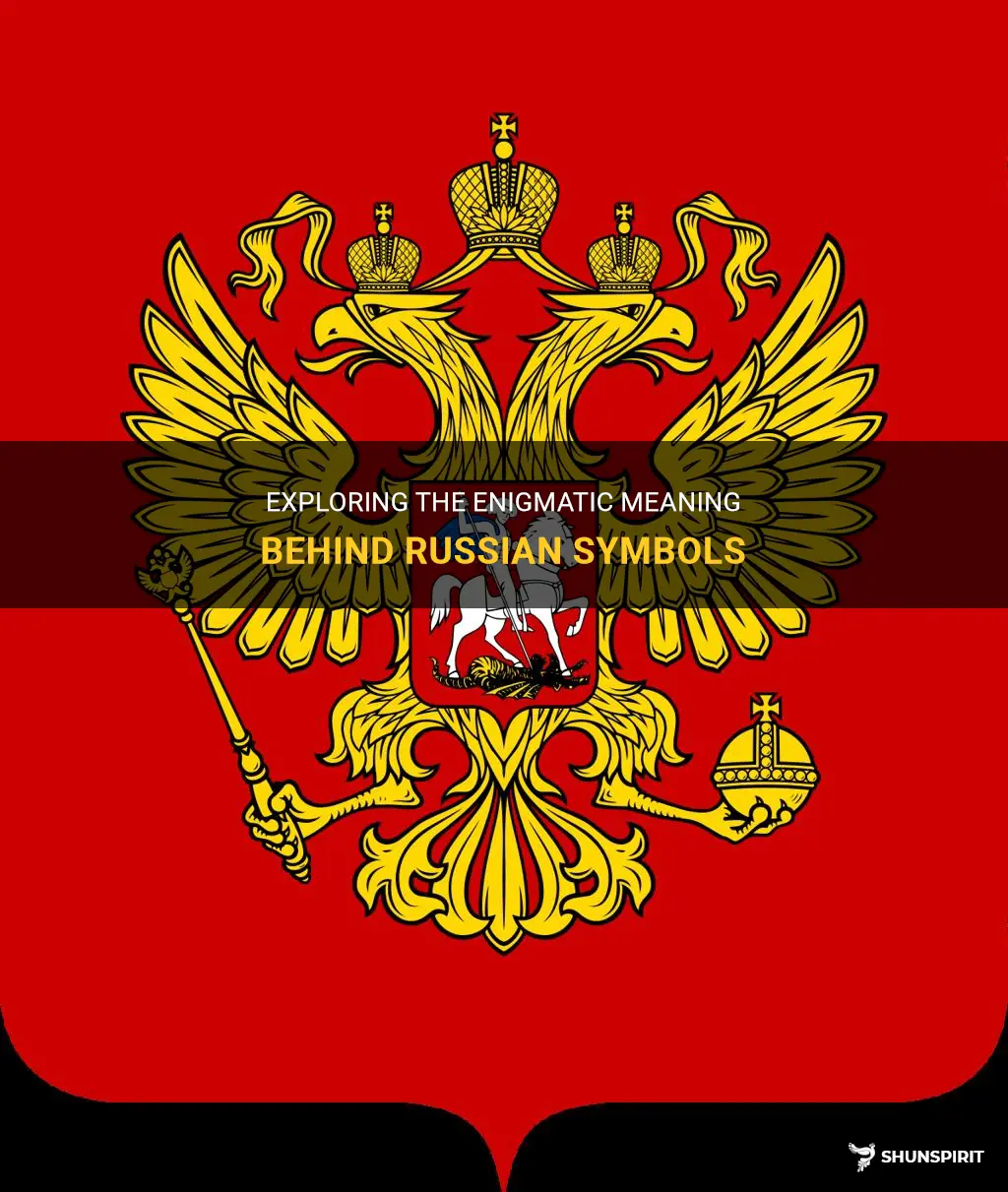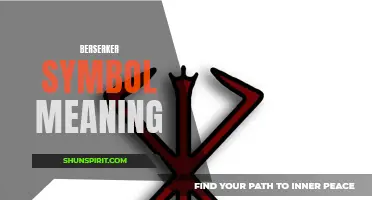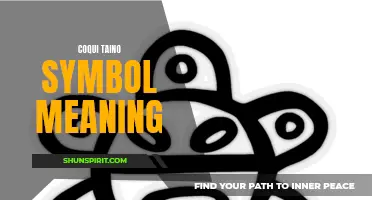
Russian symbols have deep-rooted meanings that reflect the history, culture, and spirituality of the Russian people. From the iconic Russian nesting dolls, known as Matryoshkas, to the powerful imagery found in the works of renowned Russian artists like Wassily Kandinsky, these symbols offer a unique glimpse into the rich tapestry of Russian traditions and beliefs. Whether it be the mystical significance of the famous Russian orthodox cross or the symbolism of the vividly colored onion domes adorning the country's iconic churches, each symbol holds a story waiting to be explored. Dive into the world of Russian symbolism and uncover the hidden meanings that have captivated both locals and foreigners alike for centuries.
What You'll Learn
- What are some common symbols in Russian culture and what do they represent?
- How does Russian symbolism differ from symbolism in other cultures?
- Can symbols in Russian literature be interpreted differently than in other art forms?
- How do Russian symbols reflect the country's history and cultural identity?
- Are there any controversial or sensitive symbols in Russian culture and how are they perceived?

What are some common symbols in Russian culture and what do they represent?
Symbols play a significant role in Russian culture, representing various ideas, beliefs, and traditions. Here are some of the common symbols in Russian culture and what they represent:
- Matryoshka Dolls: Matryoshka dolls, also known as Russian nesting dolls, are one of the most recognized symbols of Russia. These wooden dolls are typically painted to depict a traditional Russian woman in a colorful dress. Each doll can be opened to reveal a smaller doll inside, with the smallest one representing a baby. Matryoshka dolls symbolize maternity, fertility, and the idea of the interconnectedness of generations.
- Red Square: Located in the heart of Moscow, Red Square is a symbol of Russian power and heritage. It is surrounded by iconic landmarks such as the Kremlin, St. Basil's Cathedral, and the State Historical Museum. Red Square represents the historical and political significance of Russia, as it has been the site of many important events throughout the country's history.
- Russian Orthodox Cross: The Russian Orthodox Cross is a variation of the Christian cross, with three horizontal bars. The top bar represents the sign that Pilate placed above Jesus' head on the crucifixion cross, while the bottom slanting bar represents the footrest. The Russian Orthodox Cross is an important religious symbol in Russia and reflects the strong influence of the Russian Orthodox Church on the country's culture.
- Samovar: A samovar is a traditional Russian tea urn used to boil water for making tea. It is a symbol of Russian hospitality and a central part of tea-drinking traditions. The samovar represents the warmth and welcoming nature of Russian culture, emphasizing the importance of sharing a cup of tea with family and friends.
- Russian Bear: The Russian bear is a symbol often associated with Russia. It represents strength, resilience, and the wild nature of the country. The bear has been featured in Russian folklore, literature, and even as the national symbol for the Olympic Games held in Russia. The Russian bear symbolizes the endurance and power exhibited by the Russian people throughout history.
- Fabergé Eggs: Fabergé eggs are exquisite jeweled eggs created by the House of Fabergé during the late 19th and early 20th centuries. These eggs were originally designed as Easter gifts for Russian royalty and aristocrats. Fabergé eggs represent craftsmanship, luxury, and the opulence associated with the Russian Imperial era. They have become highly valued collector's items and are considered to be icons of Russian artistry.
- Russian Baba Yaga: Baba Yaga is a character from Russian folklore, depicted as an old witch living in a hut deep in the forest. She is known for her mystical powers and is often portrayed as an ambivalent figure, simultaneously offering guidance and posing threats to those who encounter her. Baba Yaga represents the duality of good and evil, highlighting the rich and diverse folklore traditions in Russian culture.
These symbols not only hold cultural significance but also serve as a means of preserving traditions and values in Russian society. They play a vital role in portraying the unique aspects of Russian culture to both its people and the rest of the world.
The Meaning Behind Kyrie Irving's Infinity Symbols
You may want to see also

How does Russian symbolism differ from symbolism in other cultures?
Russian symbolism emerged in the late 19th and early 20th centuries as a response to the changing socio-political landscape of Russia. This artistic and literary movement sought to capture the spiritual essence of the Russian people and uncover the deeper meaning behind everyday life. While symbolism can be found in various cultures around the world, Russian symbolism stands out for its unique themes, aesthetic elements, and social context.
One of the key differences between Russian symbolism and symbolism in other cultures lies in its focus on the Russian soul or national character. Russian symbolists believed that Russia had a distinct spiritual identity that set it apart from Western Europe, and their work aimed to capture this essence. They sought to explore the mystical and metaphysical aspects of the Russian psyche, often delving into themes of suffering, spirituality, and the search for truth. This focus on the Russian soul distinguishes Russian symbolism from the more universal or abstract symbolism found in other cultures.
Another distinguishing feature of Russian symbolism is its connection to the political climate of the time. The late 19th and early 20th centuries were marked by social and political upheaval in Russia, including the rapid industrialization, the rise of socialism, and the push for political reforms. Russian symbolists often used their art and literature as a means of critique and resistance against the prevailing social order. They explored themes of alienation, decadence, and the loss of traditional values, reflecting the anxieties and disillusionment felt by many Russians during this period. This political dimension sets Russian symbolism apart from symbolism in other cultures, which may focus more on personal or universal themes.
In terms of aesthetic elements, Russian symbolism is characterized by its richly symbolic language and vivid imagery. Russian symbolists drew inspiration from a wide range of sources, including folk tales, mythology, and religious texts. They often used dream-like or fantastical imagery to convey deeper meanings, and their works are imbued with a sense of mystery and ambiguity. Symbolists like Alexander Blok, Andrei Bely, and Fyodor Sologub experimented with unconventional forms and styles, incorporating elements of music, theater, and visual art into their work. This emphasis on symbolism, imagery, and experimentation sets Russian symbolism apart from other traditions where a more straightforward or literal representation may prevail.
Overall, Russian symbolism differs from symbolism in other cultures in its focus on the Russian soul, its connection to the political climate of the time, and its use of richly symbolic language and vivid imagery. Russian symbolists sought to capture the unique spiritual essence of the Russian people and explore the deeper meaning behind everyday life. Their works reflect the social and political context of their time and stand out for their unconventional forms and styles. Russian symbolism remains an important and influential artistic and literary movement, both within Russia and internationally.
Exploring the Mystical World of Bohemian Symbols and Their Profound Meanings
You may want to see also

Can symbols in Russian literature be interpreted differently than in other art forms?
Symbols in Russian literature often hold a significant level of complexity and depth that sets them apart from symbols in other art forms. Russian literature, known for its rich symbolism, often incorporates political, social, and philosophical ideas through carefully constructed symbols. These symbols can be interpreted differently than in other art forms due to the historical and cultural context of Russia, as well as the unique literary traditions that permeate through Russian literature.
One of the reasons symbols in Russian literature can be interpreted differently is the historical context in which these works were written. Russian literature was heavily influenced by political and social upheavals, such as the fall of the Tsarist regime and the rise of the Soviet Union. Many writers used symbols to critique or comment on these events, often using allegory to convey their ideas. For example, in Mikhail Bulgakov's "The Master and Margarita," the character of Woland, who represents the devil, is a symbol for the oppressive Soviet regime. This interpretation of the symbol would not necessarily be apparent in other art forms, such as painting or music, where the historical context may not be as prominent.
Moreover, Russian literature has a deep tradition of philosophical and spiritual ideas. Many writers, such as Fyodor Dostoevsky and Leo Tolstoy, delve into profound themes of morality, existentialism, and religious faith. Symbols play a crucial role in conveying these ideas, often representing complex philosophical concepts. For example, in Dostoevsky's "Crime and Punishment," the symbol of the yellow cross represents redemption and the possibility of salvation. This symbol may not carry the same depth or complexity in other art forms, where the exploration of philosophical ideas may not be as prevalent.
Additionally, the unique literary traditions of Russia also contribute to the different interpretations of symbols in Russian literature. Symbolism, a movement that originated in Russia in the late 19th century, heavily influenced many writers and their use of symbols. Symbolist poets, such as Alexander Blok and Anna Akhmatova, focused on conveying emotions, dreams, and inner worlds through enigmatic and evocative symbols. These symbols often require careful analysis and contemplation to decipher their meaning. This emphasis on symbolism in Russian literature sets it apart from other art forms, where the exploration of emotions and inner worlds may be conveyed through different means.
In conclusion, symbols in Russian literature can be interpreted differently than in other art forms due to the historical and cultural context, the philosophical ideas explored, and the unique literary traditions of Russia. These symbols often carry a deeper level of complexity and depth, conveying political, social, and philosophical ideas that may not be apparent in other art forms. The analysis and interpretation of symbols in Russian literature allow readers to delve into the intricate web of ideas and themes that characterize this unique literary tradition.
Understanding Safety Symbols: Their Meanings and Importance
You may want to see also

How do Russian symbols reflect the country's history and cultural identity?
Russian symbols have a long and complex history that reflect the country's rich cultural identity. From the recognizable red flag with a hammer and sickle to the revered double-headed eagle, these symbols represent different aspects of Russian history and nationalism.
One of the most iconic symbols of Russia is the double-headed eagle. This symbol dates back to the Byzantine era and has been used by various Russian rulers throughout history. The two heads of the eagle represent the duality of power - one head looks towards the East, symbolizing Asia, while the other head looks towards the West, symbolizing Europe. This symbol is a reminder of Russia's unique position as a country bridging the gap between two continents.
Another significant symbol is the red flag with a hammer and sickle. This symbol emerged during the Russian Revolution in 1917 and became the official emblem of the Soviet Union. The red color represents the bloodshed of the revolution and the hammer and sickle represent the unity of the industrial working class and the peasantry. This symbol became synonymous with communism and represented the socialist ideals of the Soviet regime.
In addition to these political symbols, Russian culture is rich with other symbols that reflect the country's history and traditions. The matryoshka doll, for example, is a symbol of Russian craftsmanship and creativity. These nesting dolls are intricately painted and represent the idea of unity and interconnectedness. Each doll fits inside the other, symbolizing the different layers of Russian society and the importance of family and community.
Another symbol deeply embedded in Russian culture is the onion dome, often seen on Russian Orthodox churches. These distinctive domes are brightly colored and represent the spirituality and religious devotion of the Russian people. The curved shape of the domes is said to symbolize the flames of a bonfire, representing the eternal light of God.
Furthermore, the Cyrillic alphabet is another symbol that reflects Russia's history and cultural identity. Developed in the 9th century by Saint Cyril and Saint Methodius, this alphabet is used by many countries in Eastern Europe and was specifically created to translate religious texts into the languages spoken by the Slavic people. Today, the Cyrillic alphabet is an important part of Russian culture and serves as a reminder of the country's historical ties to the Byzantine Empire and the Orthodox Christian faith.
In conclusion, Russian symbols reflect the country's history and cultural identity in a variety of ways. Whether it is through political symbols like the double-headed eagle or the hammer and sickle, or through cultural symbols like the matryoshka doll and the onion dome, these symbols are deeply rooted in Russian history and tradition. They serve as reminders of the country's unique position between East and West, its struggles and achievements, and its strong sense of national identity.
Understanding the Chemical Symbol 0 0: What Does it Mean?
You may want to see also

Are there any controversial or sensitive symbols in Russian culture and how are they perceived?
Symbols play a significant role in every culture, often carrying deep meanings and evoking strong emotions. In Russian culture, there are several symbols that hold controversial or sensitive connotations, which can vary depending on historical and cultural contexts. Understanding these symbols and their perceptions is crucial in order to appreciate and respect the Russian culture fully.
One of the most controversial symbols in Russian culture is the hammer and sickle. This emblem was prominently displayed on the flag of the Soviet Union, symbolizing the unity of the working class and peasants, as well as the victory of communism. While some Russians still hold nostalgic feelings towards the Soviet era, others view this symbol as a reminder of a repressive regime and its atrocities. As a result, the hammer and sickle evoke mixed emotions and can lead to heated debates when mentioned in public conversations.
Another symbol with sensitive connotations in Russian culture is the swastika. Although historically this symbol predates the Nazi party and was once associated with good luck and prosperity, it was tarnished by its use by Adolf Hitler and the Nazi regime. In modern times, the swastika is universally recognized as a symbol of hate, racism, and genocide. Displaying or promoting the swastika in Russia is strictly forbidden by law, and it is seen as a highly offensive and provocative symbol.
Religious symbols can also be a source of controversy in Russian culture. The most prominent religious symbol in Russia is the Russian Orthodox cross. For many Russians, this cross represents their faith, spirituality, and cultural identity. However, as Russia is a multi-religious country, some minority groups perceive the Russian Orthodox cross as a symbol of religious dominance and exclusion, causing tension between different religious communities.
Similarly, the LGBT rainbow flag has become a symbol of controversy and sensitivity in Russian culture. The Russian government has implemented strict laws against "propaganda of nontraditional sexual relationships," effectively suppressing any public display or support of LGBT rights. As a result, the rainbow flag is seen by some as a symbol of foreign influence, perversion, or even a threat to traditional values. However, there are also Russians who see the rainbow flag as a symbol of love, diversity, and equality, pushing for more openness and acceptance in society.
It is crucial to approach these symbols and their perceptions in Russian culture with sensitivity and respect. While some symbols may evoke negative emotions for some individuals, they may hold positive or nostalgic meanings for others. As outsiders, it is important to understand the context and listen to the voices of the Russian people in order to navigate these symbols respectfully and foster cultural understanding.
The Symbolic Meaning of Lions: Power, Courage, and Majestic Authority
You may want to see also
Frequently asked questions
The double-headed eagle is a prominent symbol in Russian culture and represents power and authority. It dates back to the Byzantine Empire and was adopted by the Russian Empire as a symbol of the emperor's dominion over both Eastern and Western lands.
The red star is a widely recognized symbol of both the Russian military and the Soviet Union. It has historically represented communism and the socialist ideals of the USSR. Today, it continues to be used in Russian military insignia and is seen as a symbol of pride and strength.
The Matryoshka doll, also known as the Russian nesting doll, is a symbol of Russian folk art and tradition. Each doll contains a smaller doll inside, symbolizing the concept of "matrioshka" which means motherhood and fertility. It is also seen as a symbol of unity and the interconnectedness of generations.
The hammer and sickle is a well-known symbol associated with communism and the Soviet Union. The hammer represents the industrial working class, while the sickle symbolizes the agricultural peasantry. Together, the hammer and sickle represent the alliance between the proletariat and the peasantry in the socialist revolution.
The Russian Orthodox cross, also known as the Eastern Orthodox cross, is a variant of the Christian cross. It differs from the Latin cross in that it has an additional horizontal bar near the top, representing the inscription "INRI" (Jesus of Nazareth, King of the Jews). The Russian Orthodox cross is a symbol of faith and the crucifixion of Jesus Christ, and is commonly seen in Russian Orthodox churches and religious iconography.







